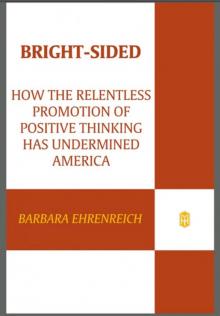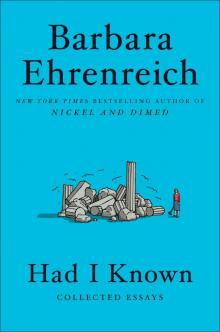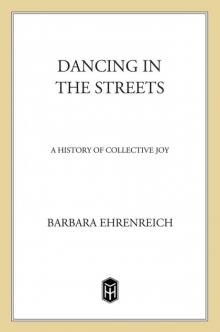- Home
- Barbara Ehrenreich
Bait and Switch: The (Futile) Pursuit of the American Dream Page 2
Bait and Switch: The (Futile) Pursuit of the American Dream Read online
Page 2
I could do this, on a temporary basis anyway, and have even done many of the things PR people routinely do: I’ve written press releases, pitched stories to editors and reporters, prepared press packets, and helped arrange press conferences. As an author, I have also worked closely with my publisher’s PR people and have always found them to be intelligent and in every way congenial.
I have also been an activist in a variety of causes over the years, and this experience too must translate into something valuable to any firm willing to hire me. I have planned meetings and chaired them; I have worked in dozens of diverse groups and often played a leadership role in them; I am at ease as a public speaker, whether giving a lengthy speech or a brief presentation on a panel—all of which amounts to the “leadership” skills that should be an asset to any company. At the very least, I could claim to be an “event planner,” capable of dividing gatherings into plenaries and break-out sessions, arranging the press coverage, and planning the follow-up events.
Even as a rough draft, the résumé took days of preparation. I had to line up people willing to lie for me, should they be called by a potential employer, and attest to the fine work I had done for them. Fortunately, I have friends who were willing to do this, some of them located at recognizable companies. Although I did not dare claim actual employment at these firms, since a call to their Human Resources departments would immediately expose the lie, I felt I could safely pretend to have “consulted” to them over the years. Suffice it to say that I gave Barbara Alexander an exemplary history in public relations, sometimes with a little event planning thrown in, and that the dissimulation involved in crafting my new résumé was further preparation for any morally challenging projects I should be called upon to undertake as a PR person.
I did not, however, embellish my new identity with an affect or mannerisms different from my own. I am not an actor and would not have been able to do this even if I had wanted to. “Barbara Alexander” was only a cover for Barbara Ehrenreich; her behavior would, for better or worse, always be my own. In fact, in a practical sense I was simply changing my occupational status from “self-employed/writer” to “unemployed”—a distinction that might be imperceptible to the casual observer. I would still stay home most days at my computer, only now, instead of researching and writing articles, I would be researching and contacting companies that might employ me. The new name and fake résumé were only my ticket into the ranks of the unemployed white-collar Americans who spend their days searching for a decent-paying job.
The project required some minimal structure; since I was stepping into the unknown, I needed to devise some guidelines for myself. My first rule was that I would do everything possible to land a job, which meant being open to every form of help that presented itself: utilizing whatever books, web sites, and businesses, for example, that I could find offering guidance to job seekers. I would endeavor to behave as I was expected to, insofar as I could decipher the expectations. I did not know exactly what forms of effort would be required of successful job seekers, only that I would, as humbly and diligently as possible, give it my best try.
Second, I would be prepared to go anywhere for a job or even an interview, and would advertise this geographic flexibility in my contacts with potential employers. I was based in Charlottesville, Virginia, throughout this project, but I was prepared to travel anywhere in the United States to get a job and then live there for several months if I found one. Nor would I shun any industry—other than those where I might be recognized—as unglamorous or morally repugnant. My third rule was that I would have to take the first job I was offered that met my requirements as to income and benefits.
I knew that the project would take a considerable investment of time and money, so I set aside ten months9 and the sum of $5,000 for travel and other expenses that might arise in the course of job searching. My expectation was that I would make the money back once I got a job and probably come out far ahead. As for the time, I budgeted roughly four to six months for the search—five months being the average for unemployed people in 200410—and another three to four months of employment. I would have plenty of time both to sample the life of the white-collar unemployed and to explore the corporate world they sought to reenter.
From the outset, I pictured this abstraction, the corporate world, as a castle on a hill—well fortified, surrounded by difficult checkpoints, with its glass walls gleaming invitingly from on high. I knew that it would be a long hard climb just to get to the door. But I’ve made my way into remote and lofty places before—college and graduate school, for example. I’m patient and crafty; I have stamina and resolve; and I believed that I could do this too.
In fact, the project, as I planned it, seemed less challenging than I might have liked. As an undercover reporter, I would of course be insulated from the real terrors of the white-collar work world, if only because I was independent of it for my income and self-esteem. Most of my fellow job seekers would probably have come to their status involuntarily, through layoffs or individual firings. For them, to lose a job is to enter a world of pain. Their income collapses to the size of an unemployment insurance check; their self-confidence plummets. Much has been written about the psychological damage incurred by the unemployed—their sudden susceptibility to depression, divorce, substance abuse, and even suicide.11 No such calamities could occur in my life as an undercover job seeker and, later, jobholder. There would be no sudden descent into poverty, nor any real sting of rejection.
I also started with the expectation that this project would be far less demanding than the work I had undertaken for Nickel and Dimed. Physically, it would be a piece of cake—no scrubbing, no heavy lifting, no walking or running for hours on end. As for behavior, I imagined that I would be immune from the constant subservience and obedience demanded of low-wage blue-collar workers, that I would be far freer to be, and express, myself. As it turns out, I was wrong on all counts.
one
Finding a Coach in the Land of Oz
Where to begin? My first foray into the world of job searching, undertaken at my computer on a gloomy December afternoon, is distinctly intimidating. These days, I have gathered from a quick tour of relevant web sites, you don’t just pore over the help-wanted ads, send off some résumés, and wait for the calls. Job searching has become, if not a science, a technology so complex that no mere job seeker can expect to master it alone. The Internet offers a bewildering variety of sites where you can post a résumé in the hope that a potential employer will notice it. Alternatively, you can use the net to apply directly to thousands of companies. But is the résumé eye-catching enough? Or would it be better to attempt face-to-face encounters at the proliferating number of “networking events” that hold out the promise of meaningful contacts?
Fortunately, there are about 10,000 people eager to assist me—“career coaches”—who, according to the coaching web sites, can help you discover your true occupational “passion,” retool your résumé, and hold your hand at every step along the way. The coaches, whose numbers have been doubling every three years, are the core of the “transition industry” that has grown up just since the midnineties, in a perhaps inevitable response to white-collar unemployment.1 Unlike blue-collar people, the white-collar unemployed are likely to have some assets to invest in their job search; they are, in addition, often lonely and depressed—a perfect market, in other words, for any service promising prosperity and renewed self-esteem. Some coaches have formal training through programs like the Career Coach Academy’s fifteen-week course; others are entirely self-anointed. You can declare yourself a coach without any credentials, nor are there any regulatory agencies looking over your shoulder—which means that, for the job seeker, it’s the luck of the draw.2
I find Morton on the web, listed as a local career coach, although—as I will soon learn—most coaching is done by phone so there is no need for geographic proximity. Morton has been there, is my thought. The background material that he sends me
shows a history of what appear to be highlevel, defense-related jobs, including, somewhat datedly, “Senior Intelligence Analyst and Branch Chief Responsible for Analyzing Soviet Military Research.” He has given seminars at Carnegie Mellon University and spoken frequently at Kiwanis and Rotary clubs. Surely he can guide my transformation into the marketable middle-level professional I aspire to be. Besides, he assures me, I will not have to pay for our first, trial session.
I have no trouble recognizing him at Starbucks in Charlottesville’s Barracks Road Mall; he’s the one wearing the “JMU” baseball cap, as promised, a description that encouraged me to come in rumpled gray slacks and sneakers. The top is better, though—black turtleneck, tweed blazer, and pearl earrings—which I am hoping will pass as “business casual.” Flustered by being five minutes late because my normal route to the mall was blocked by construction, I stumble over my new name in the handshake phase. He appears not to notice. In fact, he doesn’t seem to be much into the noticing business or perhaps already regards me as a disappointment.
After exchanging some observations on the pre-Christmas parking situation at the mall, I lay out my situation for him: I do public relations and event planning, I tell him, but I’ve been doing it on a freelance basis and am now seeking a stable corporate position with regular benefits, location flexible. How to present myself? Where to begin? I pull out the résumé that I completed over the weekend and slide it across the table toward him. In the worst-case scenario, he will grab it and quiz me on it while holding it in such a way that I will be unable to refresh my memory with an occasional glance. But he regards the stapled papers with only somewhat more enthusiasm than if a fly were advancing across the table toward his arm. Maybe he can tell without reading it, by the very format of the pages—the lack, as I now see it, of bullets and bolding—that it isn’t worth a serious coach’s attention.
But he is bringing something out of his briefcase—an 8½×11 inch transparency—which he places methodically over a sheet of white paper so that I can read: “Core Competencies and Skills,” or “the four competencies,” as he refers to them. These are Mobilizing Innovation, Managing People and Tasks, Communicating, and Managing Self. This must be what I need—an introduction to the crisp, linear concepts that shape the corporate mind. I am taking notes as fast as I can, but he assures me that he will leave me with copies, so I am free to focus on the content.
The next transparency features a picture of a harness racer and horse, and reads:
Clear mind, skillful driver
Sound spirit, strong horse.
Strong body, sound carriage.
Mind, body, spirit work as one . . .
Path to victory is clear.
The syntax is a bit disturbing, particularly the absence of articles, which gives it a kind of ESL feel, but if modern-day executives can derive management principles from Buddhism or Genghis Khan, as the business sections of bookstores suggest, surely they can imagine themselves as harness racers. The horse, driver, and carriage, Morton is telling me, symbolize Head, Heart, and Gut, but I miss which one is which. This is going to be a lot harder than I anticipated. Already, the four competencies are leaking away from memory, or maybe it should be self-evident that Mobilizing Innovation equals Head or possibly Gut.
With the next transparency, things take a seriously goofy turn. It’s titled “Three Centers of Intelligence” and illustrated with characters from The Wizard of Oz: the scarecrow, representing “Mental,” the tin man, representing “Emotional,” and the lion, representing “Instinctual.” When he teaches his course on “Spirituality and Business,” Morton is explaining, he does this with dolls. That was his wife’s idea. She said, “You should have dolls!” and you know what? She went out and found them for him. I profess to being a little sketchy about my Wizard of Oz, and Morton digresses into the back story on the tin man, trying to recall how he got such a hard “shell.” All I can think is that I’m glad he didn’t bring the dolls with him, because Starbucks has gotten crowded now and I wouldn’t want it to look like I’m being subjected to some peculiar doll-based form of therapy.
But while I am still struggling to associate the tin man with Emotional and so forth, we move away from Oz to the Enneagram, which is defined in a transparency as:
• A description of personality types
• Based on ancient learning about motivation
• A diagram easily learned and applied
• Provides clues about moving toward balance
The visuals here feature a figure composed of a number of connected triangles enclosed in a circle. I feel a dizziness that cannot be explained by the growing distance from breakfast, and not a single question occurs to me that might shed some light on the ever-deepening complexity before me. Somehow, the Enneagram leads to “The Nine Types,” which are also the “nine basic desires or passions.” Perhaps sensing my confusion, Morton tells me that, in his course, the Enneagram takes a lot of time to get across. “It’s more or less a data dump.”
I furrow my brow and nod. All around us, money is being exchanged for muffins in mutually agreeable amounts, and the corporate world continues to function in its usual mindlessly busy, rational way. But the continuance of the corporate enterprise is not something, I realize for the first time, that you can necessarily take for granted. Not if its underlying principles emanate from Oz.
It’s a great relief when the higher math of the Enneagram gives way, in the sequence of transparencies, to the familiar Wizard of Oz creatures, now seen decorating a series of grids labeled “Emotional Centered Types,” “Mentally Centered Types,” and “Instinctual Centered Types.” On the left side of each grid are five entries, the most intriguing of which is “distorted passion,” described by Morton as a “bad passion,” or one that you have to recognize and overcome. For example, the lion has as one of its distorted passions “Lust for life. I want to experience and control the entire world,” while the scarecrow is potentially burdened with “Avarice—I keep knowledge to myself to avoid being seen as incompetent.” I interrupt to ask why keeping knowledge to oneself is called avarice, and he replies evenly, “Because it’s keeping something to yourself.” Then I notice among the distorted passions, “Gluttony—I can never get enough experience.” In among the wanderings of Dorothy in Oz and the “ancient learning” of the Enneagram, Morton—or the inventor of the Enneagram—has managed to weave the Seven Deadly Sins.
What all this leads up to is that I have to take a test, the Wagner Enneagram Personality Style Scales (WEPSS), which will reveal my personality type and hence what kind of job I should be looking for. I already told Morton what kind of job I’m looking for, but obviously not in a language that fits into his elaborate personal metaphysics. I’ll take the test at home, send it to him, and then meet for an evaluation. The whole thing will cost $60.
SO THE SEARCH for a career coach who can actually help me with the mechanics of job searching continues. I register at the CoachLink web site, which nets me three e-mails offering coaching services and one phone call. I go with the phone caller, Kimberly, whose web site describes her as “a career and outplacement consultant, trainer and writer”—for showing initiative—and agree to a weekly half-hour session by phone at $400 a month, or $200 an hour. My “homework,” due on our first session, is to “fantasize” about my ideal job. What would my day be like at this ideal job?
It’s not a bad assignment. Everyone should take some time for utopian thinking, and what better occasion than when you have nothing else to do? So I fantasize about a small- to medium-size company with offices in a wooded area, mine looking out on a valley and rolling green hills. An espresso cart rolls around every morning and afternoon; there’s an onsite gym to which we’re encouraged to retreat at least once a day, and the cafeteria features affordable nouvelle cuisine. None of that goes into my written fantasy, however, which focuses on finding a balance between the intense camaraderie of my “team” and periods of creative solitude in my office, whic
h of course has a door—no cubicles for me. I put myself in charge of my team, over which I wield a collegial, “empowering” form of leadership. I am utterly fascinated by my work, whatever it is, and frequently carry on till late at night.
Kimberly, when our first session rolls around, is “excited” by my résumé, “excited” by my fantasy, and generally “excited” to be working with me. I get high marks for the fantasy job: “You’re very clear about what you want! Many clients don’t get to this stage for months. I think you’re going to be a quick study.” Already, the excitement level is beginning to exhaust me. In my irritation, I picture her as a short-haired platinum blonde, probably wearing a holiday-themed sweater and looking out from her ranch home on a lawn full of reindeer or gnomes.
As for how she sees herself: “I’ve gone through some branding processes, and I realize the brand you’re getting from me is wildly optimistic, fiercely compassionate, and totally improvisational.” I am to think of myself in the same way—as a “brand,” or at least a product.
“What do you do in PR?”
I let a beat go by, not sure if this is a test of whether I am actually what I claim to be. But this turns out to be her MO—the teasing question, followed by the dazzlingly insightful answer: “You sell things, and now you’re going to sell yourself!”
Looking down at my sweatpants and unshod feet, all of which is of course invisible to Kimberly, I mumble about lacking confidence, the tight job market, and the obvious black mark of my age. This last defect elicits a forceful “Be really aware of the negative self-talk you give yourself. Step into the take-charge person you are!”
Now comes the theoretical part. She asks me to think of two overlapping circles. One circle is me, the other is “the world of work,” and the overlapping area is “the ideal position for you.” “What you need is confidence,” Kimberly is saying. “You have to see the glass as half-full, not half-empty.” I draw the overlapping circles as she speaks, then redraw them so that they are almost entirely overlapping, thus vastly expanding my employment prospects.

 Nickel and Dimed: On (Not) Getting by in America
Nickel and Dimed: On (Not) Getting by in America Living With a Wild God
Living With a Wild God Bright-Sided
Bright-Sided Bait and Switch: The (Futile) Pursuit of the American Dream
Bait and Switch: The (Futile) Pursuit of the American Dream Dancing in the Streets: A History of Collective Joy
Dancing in the Streets: A History of Collective Joy Had I Known
Had I Known Witches, Midwives, and Nurses
Witches, Midwives, and Nurses For Her Own Good: Two Centuries of the Experts Advice to Women
For Her Own Good: Two Centuries of the Experts Advice to Women Nickel and Dimed
Nickel and Dimed Dancing in the Streets
Dancing in the Streets Bait and Switch
Bait and Switch